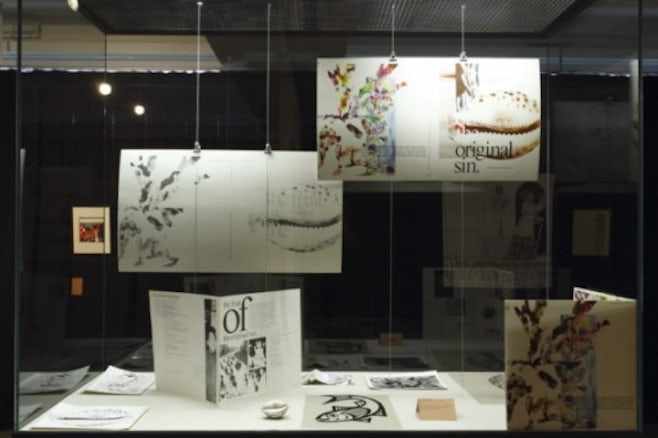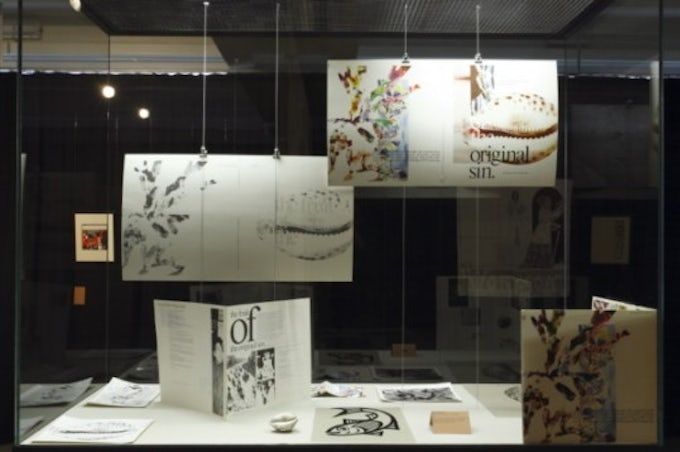
The recent group exhibition ‘Après Crépuscule’ (‘After Twilight’) at the Cologne Kunstverein revealed the hermetic world of the chic Belgian record label Les Disques du Crépuscule. Like its British counterpart Factory Records, Crépuscule’s complex identity was based on its eclectic style and ultimate control of all the fields related to its output. Emerging from the fanzine culture of the 1980s (the label shut down officially in 2006), they pushed label-work to its furthest extent – creating rare collectable items and record sleeves as coffee-table books, publishing posters as editions and even giving away logo-shaped biscuits for Christmas. Founded in 1980 in Brussels by Michel Duval and Annik Honoré, by 1984 Crépuscule had developed numerous sub-labels, foreign branches, a publishing company, a design bureau, a nightclub and an uncountable amount of musical releases, which ranged from New Wave, pop and Post-punk to poetry, sound art and minimal composition. As a whole this idiosyncratic system could provide a new model after the failure of several promising subcultures.
Compared to Factory Records, Crépuscule was never a big commercial success.01They were too eccentric for mainstream youth culture and more akin to French bohemian escapists; Factory, despite their references to Situationism, were perceptibly working-class British, and heading smoothly towards the coming hedonistic rave culture. As Factory had the Hacienda, Crépuscule had Interferences, a cultural centre in the middle of Brussels, and as Factory had Peter Saville as graphic designer, Crépuscule had Benoit Hennebert. While Saville’s graphics mostly had a clearly defined modernist design, Hennebert’s personal aestheticism was more extravagant, combining early Modernist ideas, old commercial graphics and a comic style named ‘Ligne Claire’, best known through Hergé comics like Tintin. Crépuscule developed a not easily adaptable connoisseurship, in which excess came through distinction and a refined sensual overload.
The Cologne show is curated by Oliver Tepel, a writer on music and art, and a fan and collector himself of Les Disques du Crépuscule paraphernalia. For the show, he was able to use Hennebert’s private archive, digging out sketches, drawings, collages, poster and cover designs, which were displayed in the Kunstverein next to pieces from label-related artists of that time and specially commissioned material from a generation of younger artists whose works bear reference to Crépuscule. Claus Richter installed an exact replica of a glass table with a red wine glass – a composition that appears on several early Crépuscule photographs, as well as in Julian Goethe’s detailed drawings of a stage performance, which were installed on the wall behind. Enrico David, Julia Horstmann and Christian Flamm showed paintings and collages influenced by Crépuscule’s theatrical light and formal compositions, while Lucy McKenzie’s well-crafted wall and window decorations gave the exhibition a Brussels-chic look.
With Hennebert’s and Tepel’s private collections presented in lovingly arranged vitrines, artworks merging with elegant ornamentation and hand-made spyrograph logos, the atmosphere is contrary to the usual hedge-fund-like style of curating – which reads up on a marginal art form or subculture, and comes up with research results that are either patronising or radical chic, depending on whether the ambition is sociological or sentimental. In this exhibition, a very private aesthetic sanctuary is opened, and the world of Crépuscule gets its late – though deserving – honours. At the same time, it runs the risk of making Crépuscule and Hennebert a prestigious commodity on the art market, and of creating a sense of false identity for the audience, fulfilling a longing for sentiment in a crisis-ridden society.
Entering Hennebert’s stunning visual parallel world, one slides into a dreamy bohemian ideal, with red wine glasses, ashtrays, graceful houseplants: a possibility for an ‘any where out of the world’, the view out of the window, ‘L’invitation au voyage’,02as is written on many record inlays. A bizarre fixation with James Bond appears through numerous references, while over-the-top Hollywood poster-like illustrations offer a different way to escape. One of the most famous label compilations, The Fruit of the Original Sin,03depicts a sea shell – a subtle strike against male domination. The argument is style, not content in the first place. ‘I’m the one that’s asking questions, I’m the one who will not play your game.’04

Besides Hennebert, who was responsible for the greatest part of Crépuscule’s artwork, other covers and posters were made by graphic designers Claude Stassaert, Jean-François Octave and Joël van Audenhaege. A beautiful painting by mystic-fantastic Belgian artist Denyse Willem, which was used for the cover of Crawling Chaos’s album Gas Chair,05 could be seen in the exhibition, as well as Lawrence Weiner’s cover design for his frightening, Kierkegaardian spoken word singleDeutsche Angst,06produced together with composer Peter Gordon. There were also collages by legendary Manchester artist Linder, whose band Ludus released on Crépuscule. Linder once commented, about younger artists’ enthusiasm for her work: ‘In Victorian times, people collected butterflies and put them into boxes to exhibit them – and it seemed like we would become the butterfly in the box.’07
There is a professional and very quotidian way to use ‘material’ amongst artists nowadays and different ways to participate. One quite likeable approach is the glowing playful fandom that is acted out in a well-paid art world. Another one develops fandom as a strategy to get away from artistry and to negate authorship and originality. The denial of subjectivity through selective quotation and exposing one’s intercontextuality is similar to how Facebook and MySpace users define their subjectivity through distinction. Many young artists in the show share what could be called self-definitionism – which might be the antithesis to relational aesthetics. A creation of style and exclusivity stands ostensibly contrary to potential ‘discursive situations’. Compared to the blueprint of the 1980s, where clear images of the ‘enemy’ – whether conceived of in new wave culture as Reaganite or Thatcherite governments, as well as hippie lifestyle and macho rock poses – provoked surely different but clearly enunciated reactions, today the threat has become abstract: counterterrorism, global warming, uncontrollable financial market. The counterculture, in turn, has also become abstractly delimited, with the 80s used as a role model, but in quotation marks. Or as Diedrich Diederichsen puts it, ‘Through formalism, inner space arms itself against the transparent banality of an art that lodges itself between social subsystems that function either as percolators or switching points’. The material moves away from its origin, ‘which it once represented symbolically or politically, or in whatever way, and is refined and increasingly seen as a purely aesthetic substance that can now be handled by art-immanent practices.’08
‘Win or lose you can’t refuse it / you’ll be used if you don’t use it / you’ve got to play / any way
Footnotes
-
The Benelux sister label of Factory Records was also run by Duval/Honoré. The first Crépuscule release, the record Shack Up by A Certain Ratio, was labelled Factory Benelux / Les Disques du Crépuscule (FACBN1-004).
-
Charles Baudelaire, ‘Le spleen de Paris (petits poèmes en prose)’, Gesammelte Schriften, Dreieich: Melzer 1981, p.267.
-
Various artists, The Fruit of the Original Sin, Les Disques du Crépuscule, TWI 035, 1981.
-
Ludus, ‘Mirror Mirror’, The Seduction, New Hormones, 1981.
-
Factory Benelux, FBN 6, 1982.
-
Lawrence Weiner & Peter Gordon, Deutsche Angst, Les Disques du Crépuscule, TWI 059, 1982.
-
Linder Sterling interviewed by Oliver Tepel, Spex XXV, no.01 2006. Translation the author’s.
-
Diedrich Diederichsen, ‘Eigenblutdoping’, KiWi, Cologne 2008, p.226ff. Translation the editor’s.
